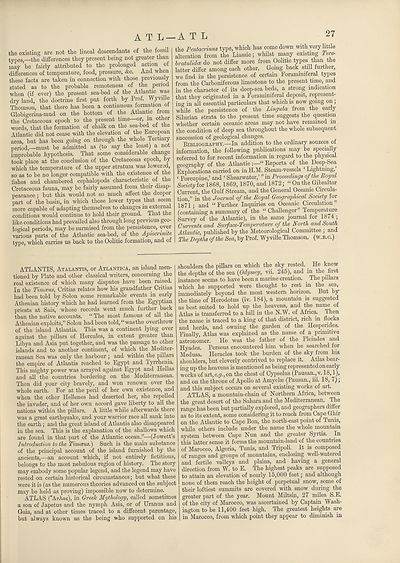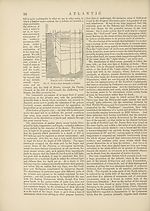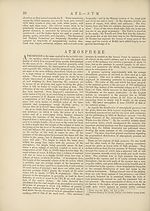Encyclopaedia Britannica > Volume 3, Athens-BOI
(39) Page 27
Download files
Complete book:
Individual page:
Thumbnail gallery: Grid view | List view

A T L-
the existing are not the lineal descendants of the fossil
types—the differences they present being not greater than
may be fairly attributed to the prolonged action of
differences of temperature, food, pressure, &c. And when
these facts are taken in connection with those previously
stated as to the probable remoteness of the period
when (if ever) the present sea-bed of the Atlantic was
dry land, the doctrine first put forth by Prof. Wyville
Thomson, that there has been a continuous formation ot
Globigerina-mud on the bottom of the Atlantic from
the Cretaceous epoch to the present time or, in other
words, that the formation of chalk on the sea-bed ot the
Atlantic did not cease with the elevation of the European
area, but has been going on through the whole Tertiary-
period,—must be admitted as (to say the least) a no
improbable hypothesis. That some considerable change
took place at the conclusion of the Cretaceous epoch, by
which the temperature of the upper stratum was lowered,
so as to be no longer compatible with the existence of the
fishes and chambered cephalopods characteristic of the
Cretaceous fauna, may be fairly assumed from their disap¬
pearance ; but this would not so much affect the deeper
part of the basin, in which those lower types that seem
more capable of adapting themselves to changes in external
conditions would continue to hold their ground. That the
like conditions had prevailed also through long previous geo¬
logical periods, may be surmised from the persistence, over
various parts of the Atlantic sea-bed, of the Apiocnnite
type, which carries us back to the Oolitic formation, and of
■ A T L 27
the Pentacrinus type, which has come down with very httle
alteration from the Liassic; whilst many existing Tere-
bratulidce do not differ more from Oolitic types than the
latter differ among each other. Going back still further,
we find in the persistence of certain Foramimferal types
from the Carboniferous limestone to the present time, and
in the character of its deep-sea beds, a strong indication
that they originated in a Foraminiferal deposit, represent¬
ing in all essential particulars that which is now going on ;
while the persistence of the Lingula from the early
Silurian strata to the present time suggests the question
whether certain oceanic areas may not have remained in
the condition of deep sea throughout the whole subsequent
succession of geological changes.
Bibliography.—In addition to the ordinary sources of
information, the following publications may be specially
referred to for recent information in regard to the physical
geography of the Atlantic“ Reports of the Deep-Sea
Explorations carried on inH.M. Steam-vessels Lightning,
< Porcupine,’ and ‘ Shearwater,’ ” in Proceedings of the Royal
Society for 1868, 1869, 1870, and 1872; “ On the Gibraltar
Current, the Gulf Stream, and the General Oceanic Circula¬
tion,” in the Journal of the Royal Geographical Society for
1871 • and “Further Inquiries on Oceanic Circulation’'
(containing a summary of the “ Challenger” Temperature
Survey of the Atlantic), in the same journal for 1874 ,
Currents and Surface-Temperature of the North and South
Atlantic, published by the Meteorological Committee ; and
The Depths of the Sea, by Prof. Wyville Thomson, (w.b. c. )
ATLANTIS, Atalantis, or Atlantica, an island men- s
tioned by Plato and other classical writers, concerning the t
real existence of which many disputes have been raised, i
In the Timceus, Critias relates how his grandfather Critias i
had been told by Solon some remarkable events in early i
Athenian history which he had learned from the Egyptian 1
priests at Sais, whose records went much further back i
than the native accounts. “ The most famous of all the .
Athenian exploits,” Solon had been told, “was the overthrow
of the island Atlantis. This was a continent lying over :
against the pillars of Hercules, in extent greater than
Libya and Asia put together, and was the passage to other
islands and to another continent, of which the Mediter¬
ranean Sea was only the harbour ; and within the pillars
the empire of Atlantis reached to Egypt and Tyrrhenia.
This mighty power was arrayed against Egypt and Hellas
and all the countries bordering on the Mediterranean.
Then did your city bravely, and won renown over the
whole earth. For at the peril of her own existence, and
when the other Hellenes had deserted her, she repelled
the invader, and of her own accord gave liberty to all the
nations within the pillars. A little while afterwards there
was a great earthquake, and your warrior race all sank into
the earth ; and the great island of Atlantis also disappeared
in the sea. This is the explanation of the shallows which
are found in that part of the Atlantic ocean.”—(Jowett’s
Introduction to the Timceusf Such is the main substance j
of the principal account of the island furnished by the
ancients,—an account which, if not entirely fictitious,
belongs to the most nebulous region of history. The story
may embody some popular legend, and the legend may have
rested on certain historical circumstances; but what these
were it is (as the numerous theories advanced on the subject
may be held as proving) impossible now to determine.
ATLAS fArAas), in Greek Mythology, called sometimes
a son of Japetus and the nymph Asia, or of Uranus and
Gaia, and at other times traced to a different parentage,
but always known as the being who supported on his
shoulders the pillars on which the sky rested. He knew
the depths of the sea (Odyssey, vii. 245), and in the first
instance seems to have been a marine creation. . The pillars
which he supported were thought to rest in the sea,
immediately beyond the most western horizon. But by
the time of Herodotus (iv. 184), a mountain is suggested
as best suited to hold up the heavens, and the name of
Atlas is transferred to a hill in the N.W. of Africa,. Then
the name is traced to a king of that district, rich in flocks
and herds, and owning the garden of the Hesperides.
Finally, Atlas was explained as the name of a primitive
astronomer. He was the father of the Pleiades and
Hyades. Perseus encountered him when he searched for
Medusa. Heracles took the burden of the sky from his
shoulders, but cleverly contrived to replace it. Atlas bear¬
ing up the heavens is mentioned as being represented on early
works of art, e.g., on the chest of Cypselus (Pausan., v. 18,1),
and on the throne of Apollo at Amy eke (Pausan., iii. 18, 7),
and this subject occurs on several existing works of art.
ATLAS, a mountain-chain of Northern Africa, between
the great desert of the Sahara and the Mediterranean. The
range has been but partially explored, and geographers differ
as to its extent, some considering it to reach from Cape Ghir
on the Atlantic to Cape Bon, the north-east point of Tunis,
while others include under the name the whole mountain
system between Cape Nun and the greater Syrtis. In
this latter sense it forms the mountain-land of the countries
of Marocco, Algeria, Tunis, and Tripoli. _ It is composed
of ranges and groups of mountains, enclosing well-watered
and fertile valleys and plains, and having a general
direction from W. to E. The highest peaks are supposed
to attain an elevation of nearly 15,000 feet; and although
none of them reach the height of perpetual snow, some of
their loftiest summits are covered with snow during the
greater part of the year. Mount Miltsin, 27 miles S.E.
of the city of Marocco, was ascertained by Captain Wash¬
ington to be 11,400 feet high. The greatest heights are
in Marocco, from which point they appear to diminish in
the existing are not the lineal descendants of the fossil
types—the differences they present being not greater than
may be fairly attributed to the prolonged action of
differences of temperature, food, pressure, &c. And when
these facts are taken in connection with those previously
stated as to the probable remoteness of the period
when (if ever) the present sea-bed of the Atlantic was
dry land, the doctrine first put forth by Prof. Wyville
Thomson, that there has been a continuous formation ot
Globigerina-mud on the bottom of the Atlantic from
the Cretaceous epoch to the present time or, in other
words, that the formation of chalk on the sea-bed ot the
Atlantic did not cease with the elevation of the European
area, but has been going on through the whole Tertiary-
period,—must be admitted as (to say the least) a no
improbable hypothesis. That some considerable change
took place at the conclusion of the Cretaceous epoch, by
which the temperature of the upper stratum was lowered,
so as to be no longer compatible with the existence of the
fishes and chambered cephalopods characteristic of the
Cretaceous fauna, may be fairly assumed from their disap¬
pearance ; but this would not so much affect the deeper
part of the basin, in which those lower types that seem
more capable of adapting themselves to changes in external
conditions would continue to hold their ground. That the
like conditions had prevailed also through long previous geo¬
logical periods, may be surmised from the persistence, over
various parts of the Atlantic sea-bed, of the Apiocnnite
type, which carries us back to the Oolitic formation, and of
■ A T L 27
the Pentacrinus type, which has come down with very httle
alteration from the Liassic; whilst many existing Tere-
bratulidce do not differ more from Oolitic types than the
latter differ among each other. Going back still further,
we find in the persistence of certain Foramimferal types
from the Carboniferous limestone to the present time, and
in the character of its deep-sea beds, a strong indication
that they originated in a Foraminiferal deposit, represent¬
ing in all essential particulars that which is now going on ;
while the persistence of the Lingula from the early
Silurian strata to the present time suggests the question
whether certain oceanic areas may not have remained in
the condition of deep sea throughout the whole subsequent
succession of geological changes.
Bibliography.—In addition to the ordinary sources of
information, the following publications may be specially
referred to for recent information in regard to the physical
geography of the Atlantic“ Reports of the Deep-Sea
Explorations carried on inH.M. Steam-vessels Lightning,
< Porcupine,’ and ‘ Shearwater,’ ” in Proceedings of the Royal
Society for 1868, 1869, 1870, and 1872; “ On the Gibraltar
Current, the Gulf Stream, and the General Oceanic Circula¬
tion,” in the Journal of the Royal Geographical Society for
1871 • and “Further Inquiries on Oceanic Circulation’'
(containing a summary of the “ Challenger” Temperature
Survey of the Atlantic), in the same journal for 1874 ,
Currents and Surface-Temperature of the North and South
Atlantic, published by the Meteorological Committee ; and
The Depths of the Sea, by Prof. Wyville Thomson, (w.b. c. )
ATLANTIS, Atalantis, or Atlantica, an island men- s
tioned by Plato and other classical writers, concerning the t
real existence of which many disputes have been raised, i
In the Timceus, Critias relates how his grandfather Critias i
had been told by Solon some remarkable events in early i
Athenian history which he had learned from the Egyptian 1
priests at Sais, whose records went much further back i
than the native accounts. “ The most famous of all the .
Athenian exploits,” Solon had been told, “was the overthrow
of the island Atlantis. This was a continent lying over :
against the pillars of Hercules, in extent greater than
Libya and Asia put together, and was the passage to other
islands and to another continent, of which the Mediter¬
ranean Sea was only the harbour ; and within the pillars
the empire of Atlantis reached to Egypt and Tyrrhenia.
This mighty power was arrayed against Egypt and Hellas
and all the countries bordering on the Mediterranean.
Then did your city bravely, and won renown over the
whole earth. For at the peril of her own existence, and
when the other Hellenes had deserted her, she repelled
the invader, and of her own accord gave liberty to all the
nations within the pillars. A little while afterwards there
was a great earthquake, and your warrior race all sank into
the earth ; and the great island of Atlantis also disappeared
in the sea. This is the explanation of the shallows which
are found in that part of the Atlantic ocean.”—(Jowett’s
Introduction to the Timceusf Such is the main substance j
of the principal account of the island furnished by the
ancients,—an account which, if not entirely fictitious,
belongs to the most nebulous region of history. The story
may embody some popular legend, and the legend may have
rested on certain historical circumstances; but what these
were it is (as the numerous theories advanced on the subject
may be held as proving) impossible now to determine.
ATLAS fArAas), in Greek Mythology, called sometimes
a son of Japetus and the nymph Asia, or of Uranus and
Gaia, and at other times traced to a different parentage,
but always known as the being who supported on his
shoulders the pillars on which the sky rested. He knew
the depths of the sea (Odyssey, vii. 245), and in the first
instance seems to have been a marine creation. . The pillars
which he supported were thought to rest in the sea,
immediately beyond the most western horizon. But by
the time of Herodotus (iv. 184), a mountain is suggested
as best suited to hold up the heavens, and the name of
Atlas is transferred to a hill in the N.W. of Africa,. Then
the name is traced to a king of that district, rich in flocks
and herds, and owning the garden of the Hesperides.
Finally, Atlas was explained as the name of a primitive
astronomer. He was the father of the Pleiades and
Hyades. Perseus encountered him when he searched for
Medusa. Heracles took the burden of the sky from his
shoulders, but cleverly contrived to replace it. Atlas bear¬
ing up the heavens is mentioned as being represented on early
works of art, e.g., on the chest of Cypselus (Pausan., v. 18,1),
and on the throne of Apollo at Amy eke (Pausan., iii. 18, 7),
and this subject occurs on several existing works of art.
ATLAS, a mountain-chain of Northern Africa, between
the great desert of the Sahara and the Mediterranean. The
range has been but partially explored, and geographers differ
as to its extent, some considering it to reach from Cape Ghir
on the Atlantic to Cape Bon, the north-east point of Tunis,
while others include under the name the whole mountain
system between Cape Nun and the greater Syrtis. In
this latter sense it forms the mountain-land of the countries
of Marocco, Algeria, Tunis, and Tripoli. _ It is composed
of ranges and groups of mountains, enclosing well-watered
and fertile valleys and plains, and having a general
direction from W. to E. The highest peaks are supposed
to attain an elevation of nearly 15,000 feet; and although
none of them reach the height of perpetual snow, some of
their loftiest summits are covered with snow during the
greater part of the year. Mount Miltsin, 27 miles S.E.
of the city of Marocco, was ascertained by Captain Wash¬
ington to be 11,400 feet high. The greatest heights are
in Marocco, from which point they appear to diminish in
Set display mode to:
![]() Universal Viewer |
Universal Viewer | ![]() Mirador |
Large image | Transcription
Mirador |
Large image | Transcription
Images and transcriptions on this page, including medium image downloads, may be used under the Creative Commons Attribution 4.0 International Licence unless otherwise stated. ![]()
| Encyclopaedia Britannica > Encyclopaedia Britannica > Volume 3, Athens-BOI > (39) Page 27 |
|---|
| Permanent URL | https://digital.nls.uk/193650808 |
|---|
| Attribution and copyright: |
|
|---|---|
| Shelfmark | EB.17 |
|---|---|
| Description | Ten editions of 'Encyclopaedia Britannica', issued from 1768-1903, in 231 volumes. Originally issued in 100 weekly parts (3 volumes) between 1768 and 1771 by publishers: Colin Macfarquhar and Andrew Bell (Edinburgh); editor: William Smellie: engraver: Andrew Bell. Expanded editions in the 19th century featured more volumes and contributions from leading experts in their fields. Managed and published in Edinburgh up to the 9th edition (25 volumes, from 1875-1889); the 10th edition (1902-1903) re-issued the 9th edition, with 11 supplementary volumes. |
|---|---|
| Additional NLS resources: |
|

